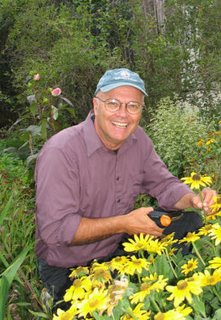The single most important gardening thing
When you write for magazines, you're supposed to write something provocative and interesting on the first line - the lead - to entice the reader to read the rest of the article. A garden is like that - there's always a first line and the point of the entire garden, like the article, is often found on the bottom line of the garden.
Blogs are filled with glorious pictures of flowers because the flowers are the leads to the garden, they are the stars. But the bottom line is the soil. No matter what flowers or veggies you put into your garden, if that soil isn't right, then you're just wasting your time.
I was really spoiled in my old farm garden because we had a sandier soil that had been gardened before. The vegetable garden had been a garden (and a pig run) so it was pretty decent soil to start with. I had the time to improve flower beds as I planted them and because they were display gardens, I took the time to make some pretty fertile soil.
My last garden - the infamous 20-foot square garden- was a rented property and was charitably called fill sand. I mulched the heck out of it with leaves and it gave me a miserable crop of vegetables and a so-so growth rate of perennials. Mind you, I compost tea'ed the thing twice a month all summer to try to get it biologically active. I suspect this year it will be a ton better.
My new garden soil has pretty good underlying soil but the fill someone has brought in to level and raise some areas is clay. I was fortunate in the first perennial shade garden area that all I had was the underlying soil. The plants were installed and wood chips have been laid down. This soil has good worm populations and after I compost tea it this summer, it will be a productive soil.
The vegetable garden is a curious mix of decent soil underneath and this layer of clay over top.
Like many things, it will take some time to work out this problem. I killed the grass this spring (well, most of it anyway) and did a quick tilling to get the veggies in. I'm not sure I should have bothered. The clay top dries out within a few minutes of watering (almost every day to get those seeds germinating) to put a tough crust on top of the soil. I'm not impressed.
And neither are the seeds. I have really spotty germination and I think it will turn out to be a waste of time to have sown many of those seeds.
So it looks like a ton of work to bring this veggie garden area into full production. Starting in one area that I'm leaving unplanted, I'll be double-digging and creating super soil. The compost tea will come out in full force this summer courtesy of my office worm bin. I'm going to construct raised beds of great soil and make small hoop houses over top of them so I can start gardening earlier and control some pests later. I'll post pictures as I get this done.
The point here - and I expect you're wondering if I was ever going to get there - is that soil is the basis of success or failure in the garden. I'm determined to succeed in this garden, so I'm going to go back to basics and make some super garden soil.
In three years, this note will remind me of where I started.


1 Comments:
Hi Doug,
Last summer, I discovered an answer to the decent soil with clay on top problem that you describe. Go to a materials recycling center that is grinding up drywall. The gypsum reclaimed from between the paper covers is so much finer than rock gypsum that in two days the clay was full of air holes and was easily turned, so that I could easily add compost and manure. I don't know why this stuff isn't selling by the ton to farmers. It also adds good calcium to the soil without changing the pH. Just make sure you wear a mask when applying, not because it is a hazardous material, but because any material that fine can get into your lungs. Remember, asbestos was a naturally occurring substance!
Soil Lady
Post a Comment
<< Home